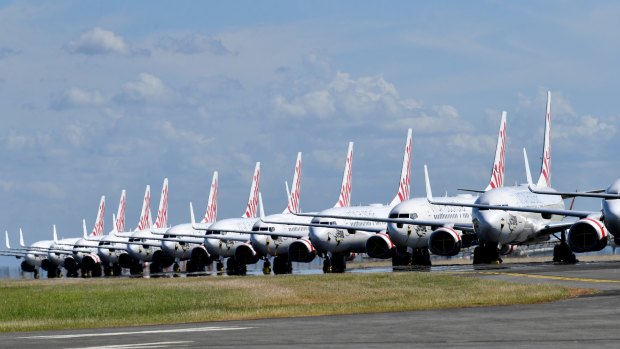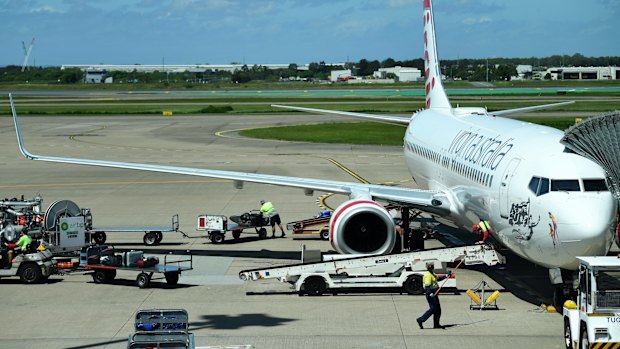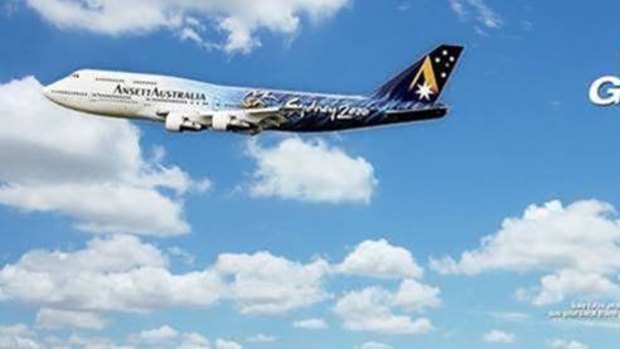This was published 4 years ago
Virgin Australia and coronavirus: What the collapse of Virgin would mean for travellers
By Craig Platt

Grounded Virgin planes parked at Brisbane Airport.Credit: AAP
Could Australia return to having just one major airline? If so, what would that look like for passengers?
The global aviation industry is in massive upheaval due to the travel restrictions put in place to prevent the spread of the SARS-CoV2 virus.
Almost every day, news comes of another hit to the aviation sector. The latest is Virgin Australia calling a trading halt as it looks to restructure a $5 billion debt. This follows the suspension of all the airline's flights with the exception of one daily return flight between Sydney and Melbourne. At the same time, Qantas has massively reduced its domestic flight numbers, along with Jetstar, while Virgin's budget offshoot Tigerair has stopped flying entirely.

Data shows airfares have dropped 37 per cent in the 20 years since Virgin Australia entered the Australian market.Credit: AAP
The federal government has now indicated it might subsidise domestic flights to get planes back in the air but what does the longer-term future hold for Australian airline passengers?
A propaganda war has broken out between Qantas and Virgin, as the latter fights for survival and the former sees an opportunity to put its domestic rival out of business. As far as Qantas is concerned, Virgin, which is 90 per cent foreign owned, shouldn't be supported by Australian taxpayers. But experts say those owners - notably Singapore Airlines and Etihad - are facing their own issues and are unlikely to come to the rescue of the struggling Australian carrier.
Why do so many airlines fail in Australia?
We are a geographically large nation, without a high-speed rail network, and heavily reliant on air travel. In fact, one of our air routes, Sydney-Melbourne, is the world's second-busiest. So why is Australia's aviation history littered with failed airlines?
Ansett, Compass and OzJet are just some of the domestic carriersto have collapsed, some having existed for only a few years.
But according to veteran aviation commentator and editor of AirlineRatings.com, Geoffrey Thomas, this problem is not unique to Australia.
"They not only fail here, they fail everywhere," he said. "Aviation is not a very profitable industry. Profit margins tend to be between one and four per cent."
Virgin Australia has asked the federal government for a $1.4 billion loan in order to ensure its survival, warning that Australia risks going back to a monopoly if the airline collapses. The airline had already been struggling to turn a profit in recent years.
While Qantas CEO Alan Joyce has lobbied the federal government against a Virgin bailout, Virgin is warning that domestic airfares will skyrocket if Qantas, with its subsidiary, Jetstar, becomes the only domestic carrier in the country.
What would it mean for passengers?
In the short term, there's little doubt airfares would rise if Virgin (and its budget rival to Jetstar, Tigerair) stopped flying.
Australians have enjoyed cheap air travel for more than a decade. Until the coronavirus outbreak, even accounting for inflation, air travel had never been cheaper.
According to figures from the Bureau of Infrastructure, Transport and Regional Economics, airfares have gone down, on average, 37 per cent since Virgin entered the market.
"Prior to Virgin's entry to the market, fares had been rising," said Thomas. Virgin's initial entry into the market as Australia's first low-cost carrier also forced Qantas to launch its own budget airline, Jetstar, to compete, he says.
Virgin's CEO Paul Scurrah has flagged the potential for price rises under a Qantas monopoly in an interview with the Sydney Morning Herald and The Age.
"If we want to go back to year 2000s sales prices of Melbourne-Sydney for $800, then that's what we need to be ready for," he said.
To support its case, Virgin dug up several old Ansett advertisements showing one-way fares much higher than those we have been paying in recent years. One 1999 ad for an Ansett sale showed one-way flights from Melbourne to Sydney for $499 and one-way to Port Douglas for a whopping $799.

"Higher airfares are the last thing you want at a time when we'll be trying to get the tourism industry back on its feet," said Thomas.
Peter Harbison, from aviation analysts CAPA - Centre for Aviation, agrees. "It's not just about the fares, it's about the routes and destinations."
"It is the tourism operators and the tourist destinations that will be the real losers out of this."
What about international flights?
The collapse of Virgin wouldn't have much of an effect on the cheap international fares Australians have been enjoying. Virgin Australia has always been a largely domestic operation, only adding its first international route (under the brand "V Australia") in 2009. Its international operations have not grown significantly in that time.
Beyond the airline's long-running Australia-Los Angeles routes, it has had several failed attempts at expanding to include other destinations. Routes to South Africa, Abu Dhabi and, most recently, Hong Kong, have all been short lived. Virgin's latest route is Japan, though its launch just as the coronavirus hit turned out to be terrible timing.
For Australian passengers, there has been an abundance of airline choices on many international routes - we have been able to reach Europe by flying through Asia or the Middle East (or Perth), and there has also been much greater choice on flights to North America, with non-stop flights from east coast cities into five US mainland cities, plus Honolulu and Vancouver in Canada.
"We've been very lucky with the Gulf carriers coming into the Australian market," said Harbison. But he warned that, such is the impact of the coronavirus, that we may not see the competitive fares we've enjoyed on international routes in recent years again for a long time.
Could another airline fill the gap?
Various airlines have been mentioned as likely candidates for the Australian domestic market if Virgin goes under, including Chinese airlines, Singapore Airlines, Air New Zealand and Europe's largest and cheapest carrier, Ryanair.
"I don't think Ryanair would dream of coming here, and I don't think Australians would want them - they make Jetstar look like luxury," said Thomas.
Singapore Airlines and Air New Zealand might be interested but it would take at least a year and while they might serve the major trunk routes, they wouldn't serve regional Australia, he said.
Harbison agrees that the gap left by Virgin could not be easily filled.
"You can forget about that," he said. "It took Virgin six to seven years to actually become competitive with Qantas."
"Anyone who thinks someone can come in and rise from the ashes of Virgin is dreaming."
What happens next?
Virgin is still pushing for support from the federal government for the loan, though it's understood a majority of the cabinet are opposed to the idea, despite the Australian Competition and Consumer Commission chairman Rod Sims saying "we desperately need two full-service airlines when this is over".
Thomas is in no doubt that the government needs to ensure the survival of both airlines.
"It would be immensely shortsighted if the government did not stand behind the airlines," he said. "Internationally, rival airlines in the Middle East and even the US have received massive support from governments.
"When we come out of this, the airlines need to be strong enough to compete - they can't be left bruised and battered."
See also: Three cataclysmic events changed travel forever – this is the fourth
See also: How much Australians will have to pay to get home on 'rescue' flights
Sign up for the Traveller newsletter
The latest travel news, tips and inspiration delivered to your inbox. Sign up now.